Veterinarians say that ear problems are one of the most common reasons why people bring their pets in for a visit.
 Indications are:
Indications are:
- Head shaking
- Ear scratching
- Rubbing ears on surfaces
- Redness
- Discharge
- Odor
You may notice symptoms cropping up at regular times, like during pollen season. Sometimes these irritated ears are a symptom of allergies.
Ears normally have ear wax and bacteria in them. The wax is one of the body’s products of elimination, a kind of sweat, and the bacteria changes that wax into a liquid that the body gets rid of. When your dog or cat is unhealthy, excess toxins are excreted, and a buildup occurs. If your dog or cat’s healthy bacteria aren’t strong enough to tackle the excretions, unhealthy bacteria can grow and fester. And if your pet has been on antibiotics, the ears will be low on healthy bacteria. These things lead to an ear infection.
Dogs with floppy ears often get ear infections. Dogs with stand-up ears, too, are prone to irritation because they can get dirt and debris in the ear, especially if they like running through brambles and briar patches.
If you rub a cotton ball inside the ear and it comes out smelling like yeast or cheese, or if it leaves a yellowish or blackish residue, your pet may have an ear infection. Dogs with floppy ears are more susceptible to ear problems because of poor circulation, humidity buildup, and hair in the ears. Ear mites are uncommon in dogs.
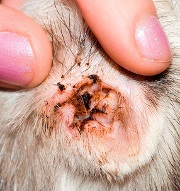 Cats, on the other hand, are more prone to ear mites. Kittens are particularly susceptible. Mites are too small to be seen by the naked eye, but if you rub a cotton ball in your pet’s ears, and it comes out with small, dark brown clumps, these may be a product of ear mites.
Cats, on the other hand, are more prone to ear mites. Kittens are particularly susceptible. Mites are too small to be seen by the naked eye, but if you rub a cotton ball in your pet’s ears, and it comes out with small, dark brown clumps, these may be a product of ear mites.
Most of the time, ear mites and mild ear infections are relatively easy to treat at home. If you take your dog or cat to a conventional veterinarian, he or she will probably prescribe antibiotics and steroids. If there is blood or pus in the ear, definitely take your pet to the vet, however, go to a holistic veterinarian. Taking unnecessary antibiotics and steroids is not good for your dog or cat.
 Another ear problem which happens less frequently but is still worth mentioning is burrs in the ears. If your dog is lucky enough to get free roaming time in fields, check the ears afterward. Seedpods, foxtails, and other plant stickers can lodge themselves inside the ear. Pull them out, if you can. If you can’t, see a veterinarian as soon as possible.
Another ear problem which happens less frequently but is still worth mentioning is burrs in the ears. If your dog is lucky enough to get free roaming time in fields, check the ears afterward. Seedpods, foxtails, and other plant stickers can lodge themselves inside the ear. Pull them out, if you can. If you can’t, see a veterinarian as soon as possible.
Herbal and Naturopathic Help
First of all, you should give your pet a home checkup once a week. Schedule a regular time so that it becomes a habit. If you find that you are not compliant with a once a week schedule, try for some other recurrence that you are more likely to stick with.
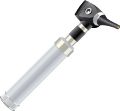 As part of the weekly checkup, inspect your dog or cat’s ears. You don’t need an otoscope, but if you want one, you can buy one online. And if you buy from smile.amazon.com, you can choose a dog or cat charity which will get a small percentage of the proceeds. However, all you really need to do is look and smell in the ear holes. You may also gently rub some cotton in the ear, not too deeply, and then smell and inspect the cotton for signs of trouble.
As part of the weekly checkup, inspect your dog or cat’s ears. You don’t need an otoscope, but if you want one, you can buy one online. And if you buy from smile.amazon.com, you can choose a dog or cat charity which will get a small percentage of the proceeds. However, all you really need to do is look and smell in the ear holes. You may also gently rub some cotton in the ear, not too deeply, and then smell and inspect the cotton for signs of trouble.
Cleaning ears
There is no standard timetable for when you ought to clean your pet’s ears. The situation varies from pet to pet, depending mostly on health and type of ear. While an inspection ought to be done regularly, overzealous cleanings can cause problems. Your dog or cat’s ears are naturally equipped with healthy bacteria, and if there is no sign of a problem, it’s best to leave the ears alone. Do your sight and smell inspections, though.
Some healthy pets with stand-up ears never need an ear cleaning, particularly if they don’t run around in dirty areas. Floppy-eared dogs, on the other hand, often need weekly cleanings. Pay particular attention during your scheduled home health checks if your pets have floppy ears, are young, unhealthy, have taken antibiotics, run through brush, or have a history of ear problems.
If you take your pet to a groomer, that groomer is probably cleaning your pet’s ears. They are also probably pulling hair out of your dog’s ears. This may be a good thing, but it also might not. Each dog is different, but groomers are usually trained to do this with every dog. They also often use an ear powder and sometimes use Nair. If you take your pet to a groomer, ask for a complete description of what they do to your pet. Be informed. Do your research and talk to your 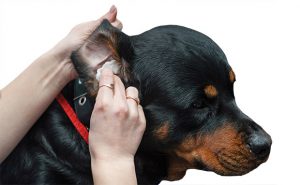 holistic veterinarian about any practices you are unsure about. And ask the groomer not to put perfume on your dog or cat when they are done. Your pet doesn’t want it, and neither should you.
holistic veterinarian about any practices you are unsure about. And ask the groomer not to put perfume on your dog or cat when they are done. Your pet doesn’t want it, and neither should you.
If your pet’s ears need cleaning, here’s how to do it:
Obtain an ear wash. If you want to make one yourself, tea tree oil is a powerful antiseptic, antiviral, antifungal, antibacterial, and all around germicide. Don’t use full strength tea tree oil as an ear cleaner, though. To make a diluted tea tree solution, see Essential Oils. Mix one ounce (30 ml) of diluted tea tree oil with one cup (250 ml) of steeped calendula or echinacea tea that has cooled, add a little grapefruit seed extract and/or a drop of essential oil of lavender, put the mixture in a bulb syringe or appropriate squeeze bottle and keep it at room temperature. It’s easier, though, to just buy an ear wash.
Be aware that essential oils can be harmful to your pets. Recently, blog posts have been exploding with warnings about cats and tea tree oil. Part of the problem, though, is that people used full strength essential oils. Another problem is that pets will lick their fur when something new or irritating gets on their bodies.
Tea tree oil can be dangerous to cats because they lack an important detoxification mechanism known as glucuronidation, which is present in most mammals. This means you need to be very cautious when using essential oils with cats, and don’t use anything that contains phenols, or your cat could go into toxic shock. In other words, you can poison your pet.
With these war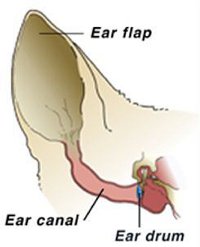 nings in mind, it should be pointed out that all all animals can be poisoned by many topical and oral medications. There’s a fine line between poison and medicine – it’s the amount of the dose that determines whether a substance is helpful or harmful, and that applies to all sorts of products from prescription drugs to herbal remedies. Any fat soluble product will build up in an animal’s system, including a human’s. This is why you need to be careful with vitamins A, D, E and K.
nings in mind, it should be pointed out that all all animals can be poisoned by many topical and oral medications. There’s a fine line between poison and medicine – it’s the amount of the dose that determines whether a substance is helpful or harmful, and that applies to all sorts of products from prescription drugs to herbal remedies. Any fat soluble product will build up in an animal’s system, including a human’s. This is why you need to be careful with vitamins A, D, E and K.
Once you have your ear wash …

Before starting the cleanse, if there is a lot of hair inside the ear, you may need to use a hemostat to pull some of it out. Open the tongs and clasp them around a few strands at a time, twirl the hemostat to wrap part of the hairs around its stem, and then perform a quick, decisive yank as if you are yanking out your child’s tooth. Hair can sometimes be pulled out with fingers, too. Only do this, though, if the hair is serious obstruction.
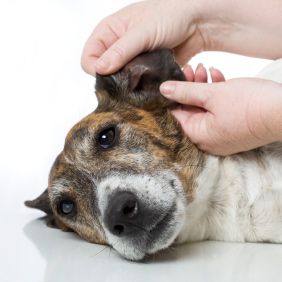 Before squirting in the ear wash, you want to get the ear-hole facing upward as best as you can. Usually this means pulling the ear back while grabbing the head with one hand (your left if you are right-handed.) The goal is to open up the ear as much as possible, and get the opening facing the ceiling, while leaving your other hand free to squeeze the bottle. If it’s easier, you can also have your pet lying on his side, like the image on the left.
Before squirting in the ear wash, you want to get the ear-hole facing upward as best as you can. Usually this means pulling the ear back while grabbing the head with one hand (your left if you are right-handed.) The goal is to open up the ear as much as possible, and get the opening facing the ceiling, while leaving your other hand free to squeeze the bottle. If it’s easier, you can also have your pet lying on his side, like the image on the left.
Squirt a few drops of ear wash on the inside of the ear flap, then a few more closer to the opening of the ear canal. Immediately massage the base of the ear, listening for the squishy sound of the liquid inside. Don’t let your pet shake the solution out until you have massaged for at least twenty seconds. Then release the ear, allow your dog or cat a good head shake, and then use gauze pads to wipe the inside of the ear. Use cotton swabs to clean the folds on the inside of the ear flap, but be careful about inserting the swabs in the ear hole. You don’t want to damage the ear drum or pack wax and debris further into the ear canal.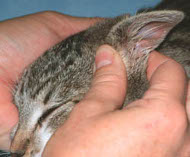
Then give your dog or cat a natural treat.
Mites
Dogs on an unhealthy diet are far more prone to ear mite infestations and infections. Healthy animals excrete less waxy toxins, and their bodies are better equipped to handle regular bodily maintenance. For optimum health and ability to fight disease, feed your pet a natural, raw diet. Less junk in, less junk out.
Some veterinary naturopaths believe that garlic is helpful for ridding your pet of parasites – ear mites, in this case. Other sources say not to give garlic. Do your research and make up your own mind about the garlic question, but know that it has been used by leading holistic veterinarians for decades. Just don’t overdose your pet.
Ear Mite Treatment – Step One
There are many oils that can be rubbed into the ear. Ear mites breathe through holes in their sides, and if oil blocks these openings, the mites will die. Vitamin E oil not only plugs the mites’ breathing holes, but it also acts as a soothing healing agent to the skin.
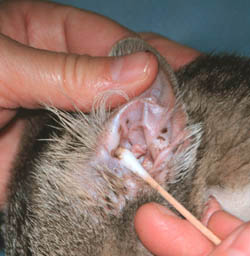 A good mixture would be about a tablespoon of olive oil, two capsules or a squirt of vitamin E oil, and a drop of garlic oil. Use a medicine dropper to squeeze about fifteen to twenty drops into the ear, roughly a dropperful, and massage the ear canal. You’ll want to hear a squishy sound. Then let your pet shake its head.
A good mixture would be about a tablespoon of olive oil, two capsules or a squirt of vitamin E oil, and a drop of garlic oil. Use a medicine dropper to squeeze about fifteen to twenty drops into the ear, roughly a dropperful, and massage the ear canal. You’ll want to hear a squishy sound. Then let your pet shake its head.
Afterward, gently wipe the inside of the ear. Use a cotton ball for the general area, and use cotton swabs (Q-Tips) for the crevices inside the ear. Do not dig deep into the ear canal. Use the oil application in both ears every other day for six days, for a total of three treatments. Let the ears rest for three days, and then continue with one of the following mite-killing treatments.
Ear Mite Treatment – Step Two – Yellow Dock Treatment
In his book, Natural Health for Dogs and Cats, Dr. Pitcairn recommends using Yellow Dock to treat ear mites. You can make an infusion, which is like making tea, and then strain the liquid. 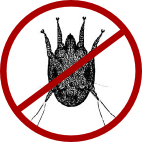 You can make a cold extract, which is like making a tea with cold water and letting it steep twelve hours. Again, strain the liquid. Or you can use a tincture and dilute it to a strength of three drops per teaspoon of pure water. Any of these forms of Yellow Dock solution can then be applied to the ear using the same method that was described above for the oil. Use at room temperature once every third day for a month.
You can make a cold extract, which is like making a tea with cold water and letting it steep twelve hours. Again, strain the liquid. Or you can use a tincture and dilute it to a strength of three drops per teaspoon of pure water. Any of these forms of Yellow Dock solution can then be applied to the ear using the same method that was described above for the oil. Use at room temperature once every third day for a month.
Ear Mite Treatment – Step Two – Tea Tree Oil Treatment
Make a mixture of one tablespoon olive oil and three drops of full strength tea tree oil. A drop of garlic oil is also helpful. Using the same method described above, apply the oil once every third day for a month. Please see the precautions about tea tree oil in the Cleaning Ears section of this page.
Ear Problems Caused by Allergies
The point of holistic medicine is to treat the body, and its environment, as a whole. It’s important not to focus on just the area displaying symptoms, but to examine the root of the problem. Red, swollen, irritated ears are, most of the time, a symptom. The underlying cause is often allergies, and it’s imperative that you get to the root of the allergic reaction instead of just treating the ears again and again.
 While you are working at remedying the allergy problem, there are some herbal treatments that can help the irritated ears.
While you are working at remedying the allergy problem, there are some herbal treatments that can help the irritated ears.
If there is a smelly, watery discharge coming from the ears, use a solution of one teaspoon calendula tincture in one cup of saline water. Massage the solution into the ear canal twice a day.
If the ears are red and irritated but have little discharge, apply aloe vera gel topically.
If the ears are red, irritated, and there is discharge, apply a mixture of almond oil and essential oil of lavender. You can also use jojoba oil in place of almond oil.
Water in the Ears
If your dog likes to swim, be mindful of a condition similar to swimmer’s ear. Pointy eared, healthy dogs don’t usually have this problem, but if your dog is not in top-notch health or has floppy ears, you may need to flush the ears after a swim. There are products you can buy for this, but a homemade solution of warm water and lemon juice will do the trick.
 Use about a teaspoon of lemon juice to one-third cup of water, and squeeze it in the ear with a bulb syringe or medicine dropper. The citric acid helps prevent bacterial or fungal growth. You can also use apple cider vinegar. If the solution seems to sting too much, lower the acidic concentration by adding more warm water.
Use about a teaspoon of lemon juice to one-third cup of water, and squeeze it in the ear with a bulb syringe or medicine dropper. The citric acid helps prevent bacterial or fungal growth. You can also use apple cider vinegar. If the solution seems to sting too much, lower the acidic concentration by adding more warm water.
After your pet shakes its head, dry the insides of the ears with tissue or absorbent cotton. Don’t rub the skin but try to get it as dry as possible. If your dog has hair in the ears, read the section, above, on how to remove ear hair.
Homeopathy
For allergic, red, irritated ears use Pulsatilla 6c once every third day for thirty days. Allow no food ten minutes before or after treatment.
For excess wax, or irritation that Pulsatilla didn’t completely clear up, use Silicea 30c every 12 hours for three treatments. Allow no food thirty minutes before or after treatment. Wait one month, then reassess.
If irritation is noticed in the early stage, when the ear flap shows a reddish inflammation, give Sulphur 30c once daily for one week.
Also for irritation in its early stage, but when the ear is very hot, give Belladonna 30c one time for one treatment. Allow no food thirty minutes before or after treatment. Alternatively, give Belladonna 6c every three to four hours for one week. If you don’t see signs of improvement after twenty-four hours, try a different treatment. If the Belladonna treatment was effective, wait a couple of days and then follow up with one dose of Calcarea carbonica 30c to prevent a recurrence.
If there is a very itchy rash, reddened ear flap, and possibly vesicles present, give Rhus tox 6c every three to four hours until the symptoms are gone. Allow no food ten minutes before or after treatment. If symptoms show no sign of improvement after twenty-four hours, try a different method and call  your holistic veterinarian.
your holistic veterinarian.
For extremely painful ears, give Hepar sulphuris calcareum 30c every four hours for a total of three treatments. Allow no food ten minutes before or after treatment.
There are more homeopathic treatments than these, but remember that it’s important to treat the underlying condition. In this case, that usually means the allergy. Don’t just keep treating the symptoms.
Also, don’t let recurring ear problems get out of hand or continue too long. If left untreated, the ear tissues can become permanently disfigured, and can lead to other ailments, including deafness.